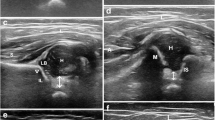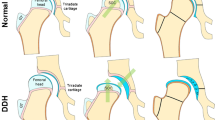Abstract
Developmental dysplasia of the hip (DDH) is the most common anatomical pathology present in newborns. DDH is the most common orthopaedic disorder in newborns, with incidences cited from 4.4% to 51.8% depending on risk factors, populations and method of reporting. Traditionally, the standard physical exam for newborns includes the Barlow and Ortolani maneuvers. If either is positive by the pediatrician, the baby is then sent for evaluation by a pediatric orthopaedic surgeon. At this stage, either the pediatrician or pediatric orthopaedic surgeon obtains an ultrasound—the gold standard for DDH diagnosis. When early identification and treatment are not in place, it can lead to significant consequences on an individual’s health and financial and public health implications for society at large. This is a detailed technique guide aimed to help physicians consistently perform thorough US evaluations of pediatric hips in order to successfully screen, diagnosis and manage treatment of DDH.
Similar content being viewed by others
Change history
30 August 2022
A Correction to this paper has been published: https://doi.org/10.1007/s43465-022-00725-1
References
Bialik, V., Bialik, G. M., Blazer, S., Sujov, P., Wiener, F., & Berant, M. (1999). Developmental dysplasia of the hip: a new approach to incidence. Pediatrics, 103(1), 93–99.
Litrenta, J., et al. (2020). Ultrasound evaluation of pediatric orthopaedic patients. Journal of American Academy of Orthopaedic Surgeons. https://doi.org/10.5435/jaaos-d-17-00895 Publish Ahead of Print.
Castañeda, P. (2009). Pediatric hip dysplasia and evaluation with ultrasound. Pediatric Health, 3(5), 465–472.
Stawicki, S. P., & Bahner, D. P. (2015). Modern sonology and the bedside practitioner: evolution of ultrasound from curious novelty to essential clinical tool. European Journal of Trauma and Emergency Surgery, 41, 457–460.
Royall, N. A., Farrin, E., Bahner, D. P., & Stawicki, S. P. (2011). Ultrasound-assisted musculoskeletal procedures: a practical overview of current literature. World Journal of Orthopedics, 2(7), 57–66. https://doi.org/10.5312/wjo.v2.i7
Clarke, N. M. P., & Castañeda, P. (2012). Strategies to improve nonoperative childhood management. Orthopedic Clinics of North America, 43(3), 281–289. https://doi.org/10.1016/j.ocl.2012.05.002
Martus, J. E. (2016). Orthopaedic knowledge update. American Academy of Orthopaedic Surgeons.
Castaneda, P. (2016). Orthopaedic knowledge update. American Academy of Orthopaedic Surgeons. Chapter 20. Developmental dysplasia of the hip.
Pavlik, A. (1992). The functional method of treatment using a harness with stirrups as the primary method of conservative therapy for infants with congenital dislocation of the hip. Clinical Orthopaedics and Related Research, 281, 4–10.
Mubarak, S., Garfin, S., Vance, R., McKinnon, B., & Sutherland, D. (1981). Pitfalls in the use of the Pavlik harness for treatment of congenital dysplasia, subluxation, and dislocation of the hip. The Journal of Bone and Joint Surgery. American Volume, 63(8), 1239–1248.
Yu, J., Duan, F., Guo, W., et al. (2021). Consistency of indices obtained via hip medial ultrasound and magnetic resonance imaging in reduction and spica cast treatment for developmental dysplasia of the hip. Ultrasound in Medicine and Biology, 47(1), 58–67.
van Douveren, F. Q., Pruijs, H. E., Sakkers, R. J., Nievelstein, R. A., & Beek, F. J. (2003). Ultrasound in the management of the position of the femoral head during treatment in a spica cast after reduction of hip dislocation in developmental dysplasia of the hip. The Journal of Bone and Joint Surgery. British Volume, 85(1), 117–120.
Eberhardt, O., Zieger, M., Wirth, T., & Fernandez, F. (2009). Determination of femoral head position with transinguinal ultrasound in DDH treatment. Zeitschrift fur Orthopadie und Unfallchirurgie, 147(6), 727–733.
Beek, F. J., Nievelstein, R.-J., Pruijs, H. E., de Jong, P. A., & Sakkers, R. J. (2010). Transinguinal sonographic determination of the position of the femoral head after reposition and follow-up in a spica cast. Pediatric Radiology, 40(11), 1794–1799.
Smith, B. G., Kasser, J. R., Hey, L. A., Jaramillo, D., & Millis, M. B. (1997). Postreduction computed tomography in developmental dislocation of the hip: part I: analysis of measurement reliability. Journal of Pediatric Orthopedics, 17(5), 626–630.
Author information
Authors and Affiliations
Corresponding author
Ethics declarations
Conflict of interest
On behalf of all authors, the corresponding author states that there is no conflict of interest.
Ethical standard statement
This article does not contain any studies with human or animal subjects performed by the any of the authors.
Informed consent
For this type of study informed consent is not required.
Additional information
Publisher's Note
Springer Nature remains neutral with regard to jurisdictional claims in published maps and institutional affiliations.
In this article the author name Ajay Kanakamedala was incorrectly written as Ajay Kanakalamedala.
Supplementary Information
Below is the link to the electronic supplementary material.
Supplementary file1 (MP4 370825 kb)
Rights and permissions
Springer Nature or its licensor holds exclusive rights to this article under a publishing agreement with the author(s) or other rightsholder(s); author self-archiving of the accepted manuscript version of this article is solely governed by the terms of such publishing agreement and applicable law.
About this article
Cite this article
Herrero, C., Jejurikar, N., Kanakamedala, A. et al. Point of Care Ultrasound as Performed by the Clinician for the Enhancement of Physical Examination: A Technique Guide for Developmental Hip Dysplasia. JOIO 55, 1597–1600 (2021). https://doi.org/10.1007/s43465-021-00570-8
Received:
Accepted:
Published:
Issue Date:
DOI: https://doi.org/10.1007/s43465-021-00570-8




